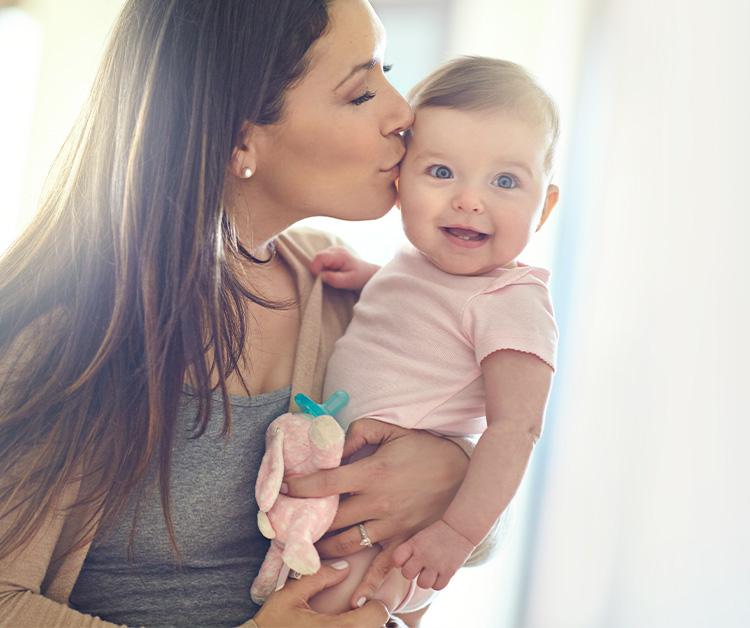Website maintenance scheduled Jan. 9-12; Rebates unavailable Jan. 5-20.

Here are some simple developmental activities for your 3-month-old to encourage your baby as they begin to understand the world around them.
Medically reviewed by a board-certified pediatrician
Eye contact. As fascinated as you are with them, your baby is just as enthralled with you—watching you carefully while they’re awake. Talking to your 3-month-old helps them follow with their eyes and improve this skill
Tracking. A simple activity to help your 3-month-old learn to track with their eyes is by holding a rattle about eight inches from the side of their face. Get their attention by shaking it, then moving it slowly across their line of vision. They may have trouble focusing when it crosses the midline of their face at first, but that’s normal. Try shaking the rattle to recapture their attention.
Rotate toys. Giving your baby different objects to play with will help to keep them engaged. Try anything from plastic measuring cups and spoons to soft blocks and cloth books.
Peekaboo. This can be a fun 3-month-old activity to help them learn the concept of object permanence—just because they can’t see you, doesn’t mean you’re gone for good. At first your baby won’t catch on and will be surprised to see you each time you hide your face and reappear. But once they do, their surprise and delight will be contagious.
Stimulus. Your baby’s color and depth perception are still developing, which is why many toys for this age are high contrast to help develop their visual cortex. Hanging a baby-safe mirror or colorful pictures near your baby’s changing table or crib and switching them up from time to time gives your baby new, stimulating things to look at.
Reaching. Place a toy slightly out of reach and to the side of your baby when they’re on their stomach. In their attempts to reach it, they may figure out how to roll over, so make sure to have your camera ready!
Tummy time. Since it’s important for your baby to strengthen their neck and head, tummy time is a simple activity for your three-month-old to get some practice. By laying them on their stomach and placing an interesting toy in front of them, they’ll want to raise their head to check it out. You might also move the toy from side to side, allowing them to practice the basic movements in rolling over.
Balance. Propping your baby in a sitting position, with the support of cushions like a firm U-shaped pillow or the inside corner of a sofa, helps babies develop the muscles they need to balance when seated. You can shake a rattle or sing to keep their attention while they build up these muscles.
Senses. You can help your baby learn about the physical world through sensory experiences. An easy way to do this is with simple objects already around them. For instance, by placing a rattle in your baby’s hand, they’ll learn from feeling its weight and hearing its sound.
Conversation. When your baby coos or makes other sounds, cooing back and showing your excitement encourages them to talk to you more.
Second language. Do you speak a second language? Good for you! Babies have a remarkable ability to pick up more than one language, and bilingual babies reach the same communication milestones at the same time as other babies, so there’s no need to worry about causing confusion or speech delays.
Reading. When you read to your baby, try pointing out certain images. “Look at the sun.” “Look at the flower.” “What’s this? A doggie!” Even a few pages of a picture book can help develop their vocabulary.
Laughter. The saying about laughter being the best medicine also holds true for babies. Not only does it encourage more laughter between the two of you, it teaches your baby the back and forth of conversation and shows the beginning development of socialization skills.
Comfort. Picking them up and holding them often fosters attachment, which is good because you probably want to hold them all the time at this age. Responding quickly when they’re in distress helps build your baby’s sense of security.
Massage. Baby massage is a great way to help promote bonding and strengthen their sense of security. Even at three months, they’re not too young for a massage. Just remember to be gentle, use a bit of baby oil, and make sure they stay warm.
From peekaboo to tummy time, there are a lot of ways to help your 3-month-old learn and grow. In addition, let’s help ensure they get the daily nutrients they need like those found in Enfamil PREMIUM® Newborn infant formula.
All information on Enfamil, including but not limited to information about health, medical conditions, and nutrition, is intended for your general knowledge and is not a substitute for a healthcare professional's medical identification, advice, or management for specific medical conditions. You should seek medical care and consult your doctor or pediatrician for any specific health or nutrition issues. Never disregard professional medical advice or delay seeking medical treatment, care, or help because of information you have read on Enfamil.